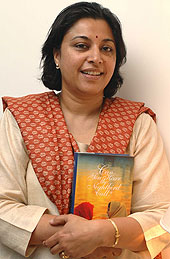 |
As Delhi burned two days after the assassination of Indira Gandhi, somewhere in Modinagar, a couple of hours by road from the capital, Anita Rau Badami met violence head-on. Sitting in a bus, paralised with fear, she saw a Sikh man being murdered and thrown off a bridge. The bus, bringing her husband and her to Delhi, was stopped at regular intervals by marauding mobs with crowbars looking for “traitors”. Townships burned and the streets emptied out into ghost towns.
“Deep in the recesses of my mind, I knew that I would write a book about these horrors one day,” she recalls. And she did. In her third and latest novel, Can You Hear the Nightbird Call? Though Badami now lives in far away Montreal, Canada, that nightmare day still comes back to haunt her.
Her close encounter with the rioting mobs of 1984 became one of the pivots of Can You Hear the Nightbird Call? (Penguin). Badami begins her story in 1928 in Panjaur, West Punjab and brings it to a close in 1986 in Vancouver. With the narrative spanning over 50 years, Badami confesses that this novel made her work far harder than her two earlier much-acclaimed books, Tamarind Mem and The Hero’s Walk.
Can You Hear the Nightbird Call? took six re-writes before it settled down to telling the story of three women whose lives are linked by love and tragedy. The story swings across from a small village in pre-Partition Punjab all the way to Vancouver and back again to Delhi. As it unfolds, it takes in Partition, Operation Blue Star, the macabre anti-Sikh riots of 1984 and the 1985 mid-air explosion of Air India’s Delhi-bound flight, AI 182, off the coast of Ireland. Inadvertently, the events inextricably weave together the women’s lives.
Dealing with such a vast canvas can’t have been easy and she says: “I’m not very good with dates, so I had to make extensive charts to ensure that the events and the dates matched — and that the narrative kept in step.” She read extensively on the events of 1984 and poured over first-hand accounts of those affected by the riots. She found Urvashi Butalia’s Other Side of Silence that tells of the experiences of women during Partition an invaluable source. “In Canada, I also followed the Air India disaster investigation very closely,” she says.
As Badami writes, she culls a lot from her own environment. She says: “The novels are written from memories of the past,” she says. Her first novel, Tamarind Mem, has many elements from her growing up years as it revolves around the railway colonies of India, quite like those she lived in as a child. The father in the story is also a mechanical engineer with the railways — like Badami’s own father — and the family moved a lot, quite like her own.
Badami has led a nomadic life, and she says that she will feel like a gypsy anywhere she goes. Born in Rourkela, Badami’s family moved to a new place every two or three years as her father was a mechanical engineer with the Railways. “As a result, I didn’t stay in a place long enough to make long-term friends. Wherever I go, I tend to feel a little unsettled. I don’t mind leading a solitary existence and my husband often calls me anti-social. But I’m very happy just with my books,” she says.
Being a railway child she lived in Kharagpur, Bilaspur, Calcutta , Lucknow, Guwahati, Mumbai and Madras. She graduated in English from the University of Madras and then studied journalism from Mumbai’s Sophia College. Though she took full-time jobs as copywriter for advertising agencies, she was a writer of novels at heart. She’d been contributing short stories and articles to children’s magazines and newspapers from the time she was 17 and she didn’t stop writing despite her jobs. “I’ve loved writing ever since I can remember but always thought that I’d write a children’s book,” she recalls.
In 1991, when she was 30, she moved to Canada with her husband who decided to do a course in environmental science in Calgary. In Canada — with lots of time to spare — she took up a creative writing course which led to a master’s degree in English Literature. Her thesis at the University of Calgary later led her to write her successful first novel, Tamarind Mem, that was published in 1996. With her debut novel, Badami surfaced at the Vancouver International Writers (& Readers) Festival, as part of the New Voices segment, and went on to earn glowing praise for it. The Globe and Mail called it “a tremendous achievement” and The Ottawa Citizen headily said that it was “as jewel-bright and weightless as a silk sari shaken out of its folds”. Clearly Badami’s first book had established her as a writer worth watching.
Considering that two of her three novels are women-centric, is it fair to accuse her of femininism? “The Hero’s Walk, my second novel, doesn’t revolve around women,” she exclaims. “But yes, I do think that women get a raw deal and I don’t mind standing up for them in my books,” she confesses. The Hero’s Walk was published in 2000 and by then Badami had moved from Calgary to Vancouver. The novel tells of the stoic manner in which some people live their lives, always brimming with hope. Again, her novel earned accolades and awards including the Regional Commonwealth Writers Prize while it was named the Washington Post Best Book of 2001.
Her books have often also been dubbed as descriptions of Indian culture, being suffused with vivid details of familiar sights, sounds and smells. “I can enter Indian minds best and would like to set every book of mine in India ,” she says.
So where is she most comfortable — India or her adopted country? She holds a dual citizenship and can slip in easily in both. But yes, like her husband always tells their 20-year-old son: “Inside our Montreal home, it will always be India.”
While currently enjoying her annual India break, she already has another book up her sleeve, as she doesn’t believe in working one just one book at a given time. No prizes for guessing where this story is set — “In India, of course,’’ she says. And she promises herself: “I hope to return some day — for good.”
Photograph by Jagan Negi











